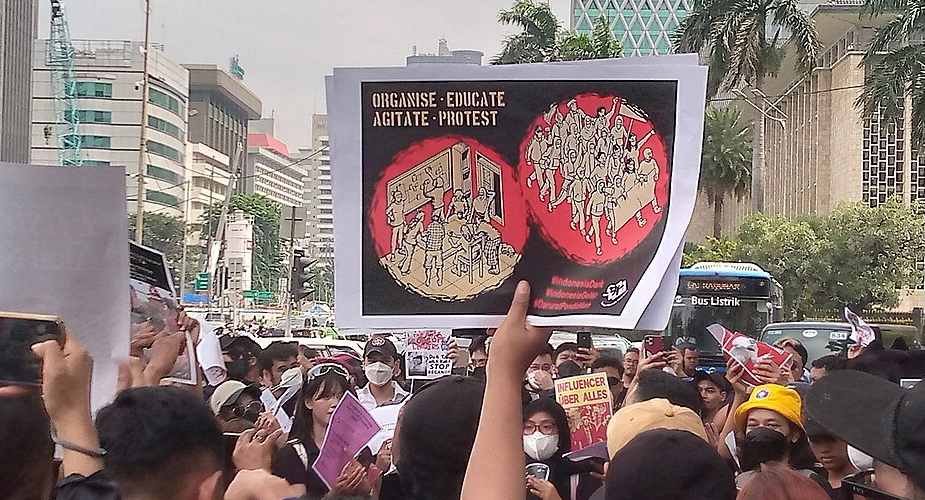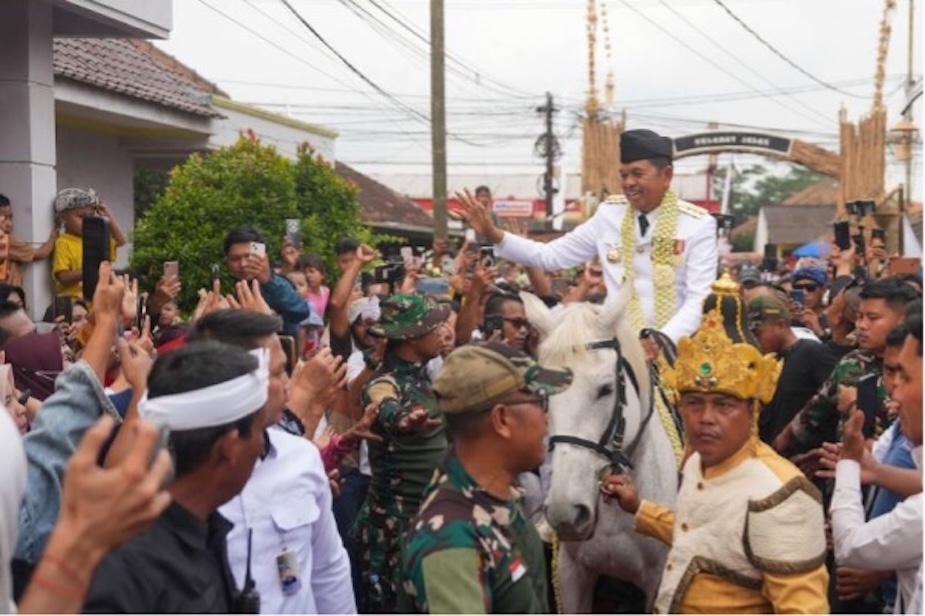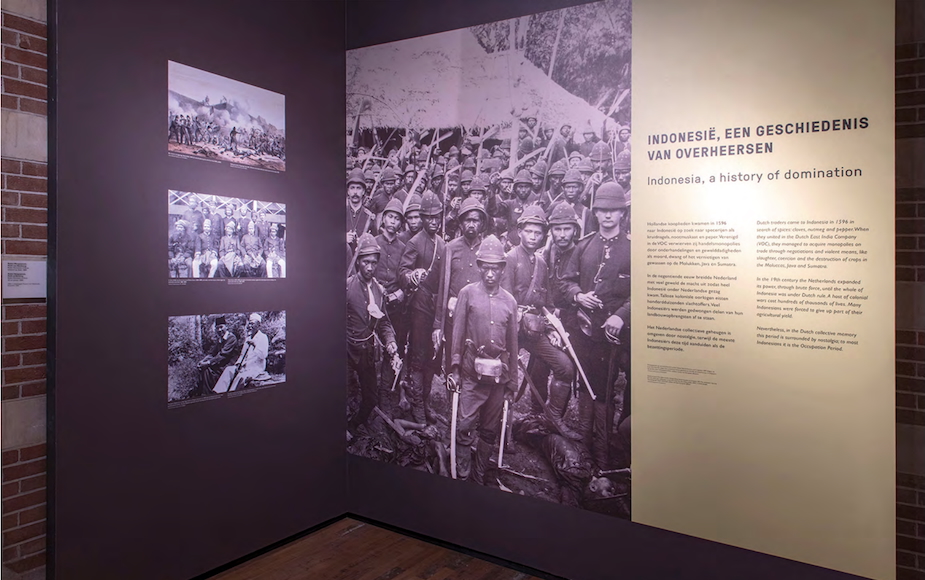There are big dangers in declaring success too soon
Sidney Jones
Hasan di Tiro and his courtiers: Partai Aceh election display in BireuenEdward Aspinall |
I want to begin with a story about Nepal. Last week, my organisation issued a report called ‘Nepal’s Faltering Peace Process ’. As you know, Nepal had been a kingdom, wracked by an insurgency in which Maoist guerrillas fought the Nepalese army. A democratic uprising ended with the king thrown out, a republic established, and a peace deal made with the rebels. Last April, in free elections, the Maoists won control of government, but today, according to my colleagues, the peace process is under threat. The Maoists have not fully adjusted to democratic politics, and some of their former rivals still see them as an illegitimate force. They have brought some problems on themselves by starting to resemble the old government in terms of patronage, corruption, and factional fighting, to the point that foot-soldiers are beginning to ask, ‘Is this what we were fighting for?’ Parts of Nepal are seeing a rise in violence accompanied by a near collapse in effective policing. The issue of how to reintegrate the former rebels into the new political system has not been resolved, and the Maoists are retaining their former military organisation. In the meantime, the Nepalese army remains a law unto itself and deeply opposed to some provisions of the peace deal.
Sound familiar? Nepal is very different from Aceh, but the point is that in both places, keeping the peace is proving harder than ending the conflict on paper. Reintegrating former combatants is never easy, nor is the transition from fighting to governing. The political consensus that helped bring a peace agreement about is often short-lived. Short-term economic interests often put longer term political goals in jeopardy. We’ve had peace in Aceh for three and a half years, since the Memorandum of Understanding (MoU) was signed by representatives of GAM (Free Aceh Movement) and the Indonesian government in August 2005. But no one should assume that peace is irreversible. Anxieties were already increasing last September and today are so high that I’m beginning to wonder if the peace process in Aceh, like Nepal, might also be at risk. If it is, we all need to be thinking very hard about out what can be done to get it back on track.
We’ve had peace in Aceh for three and a half years but no one should assume that it is irreversible
In the eyes of much of the world, Aceh is an unqualified success story. Delegations from Mindanao in the Philippines, southern Thailand and Sri Lanka are traipsing here to study how it was done. On 15 August 2006, the first anniversary of the Helsinki MoU, one analyst, Michael Morfit, wrote in the Asia Times:
Consider: the international Aceh Monitoring Mission (AMM) has earned the trust and respect of both former adversaries; armed conflict in the province has largely ceased; government troops have been significantly reduced; and GAM fighters have decommissioned their weapons and been demobilized.
The crucial basic law on Aceh governance was approved by parliament last month, and local political groups are now able to organize peacefully. Local elections contested by local candidates are planned for November 12. Even GAM’s vigorous complaints about perceived serious flaws and inadequacies of the basic law are being peacefully formulated and debated within the framework of the Helsinki agreement.
President Susilo Bambang Yudhoyono (SBY), in an op-ed the same day in the International Herald Tribune, took a more sober tone:
The agreement we have signed in Helsinki must be implemented in good faith by both sides. Peace deals have foundered in the past because of continued mistrust and poor implementation. This one has taken us further than we have ever been, but it is still just the start of an intricate and delicate process...
He noted:
We are holding GAM to its pledge to drop its demands for independence in exchange for its full participation in the political, economic, social and cultural life of the province... In the end, GAM will no longer exist and its members will no longer be armed.
Despite skepticism in some quarters, it must be made clear that the Indonesian Armed Forces are fully committed to making the peace agreement work... Many of our finest soldiers have sacrificed their lives for Aceh. It is in their honor that we labored for this peace deal that reinforces Indonesia’s territorial integrity.
What do we mean by ‘success’?
Those two assessments, very different in tone, raise the question of what we mean by ‘success’ of the peace agreement – success in whose eyes, using what criteria, and for how long?
Success in the TNI’s terms would have meant anyone but GAM
We can take three issues as examples. One is the disarmament process that took place under the auspices of the Aceh Monitoring Mission in late 2005. GAM turned in 840 weapons, the number cited in the Helsinki agreement, to the AMM by the required deadline. In the eyes of the AMM, GAM, and the international community, this was a success. The Indonesian military, the TNI, argued that several dozen of the weapons turned in did not meet agreed-on criteria and believed 840 was far short of the actual number held, but agreed reluctantly to go along with the AMM’s ruling on the matter in the interests of safeguarding the peace. In their view, as long as any GAM members retained weapons or acquired new ones, disarmament was not a success.
Another example is the Law on Governing Aceh, Law Number 11 of 2006. From the perspective of the Indonesian government, many concerned Indonesians, and the international community, the adoption of a law that enshrined most, but not all, of the provisions of the Helsinki agreement in Indonesian law was a successful compromise, especially because in the process of drafting, many potential spoilers in the Indonesian parliament were brought on board. Most GAM members and many Acehnese, however, saw the law as deeply flawed, a dilution of the whole concept of self-government as agreed to in Helsinki. Like the TNI on weapons, GAM agreed to go along with the law in the interests of keeping the peace process going, but with a determination to seek amendments later.
Finally, we can take the December 2006 local elections that led to a victories for GAM members at the provincial and district levels. For many in Aceh, the mood was euphoric; a fair vote witnessed by hundreds of monitors gave GAM a stake in the political process and seemed one more step toward cementing the peace. But for the TNI, the outcome entrenched a group in power whose commitment to the Indonesian state, in their view, was uncertain, if not half-hearted. Success in their terms would have meant anyone but GAM.
A breakdown of consensus
These different perceptions of success were absolutely normal; no peace agreement gives all sides everything they want, but disappoinments and defeats can be accommodated as long as the broad political consensus holds on the value of the peace process itself. It is this consensus that I believe is breaking down in Aceh, and several factors are responsible.
The first factor is time. The devastating 2004 tsunami is receding from view. Together with the impact of military operations under martial law and the new government of SBY and Kalla taking office in October 2004, the tsunami changed the political dynamics in a way that made peace possible. In early 2005, ending the conflict was critical to physical and psychological rebuilding, and no one wanted to be seen as obstructionist. More than four years later, the imperatives have changed, and it is no longer in everyone’s interests to support the Helsinki process. Indeed some of SBY’s opponents are seeking political advantage by questioning the involvement of foreigners and insinuating that through the peace process, Aceh is on the way to becoming another Kosovo and might soon become independent. In the past, SBY has effectively rebutted such critics; now more than ever he is needed to take an active role in shoring up peace and reopening dialogue.
Second is the behaviour of GAM and the KPA (the Aceh Transition Committee, the body established to accomodate former GAM combatants) that has led many in the military to believe they were duped by the Helsinki MoU. It is clear that not just the TNI but the president himself believed that the MoU required GAM to dissolve – as SBY said in his op-ed, ‘In the end, GAM will no longer exist.’ In fact, the MoU says nothing about GAM disbanding, only that: ‘GAM undertakes to demobilise all of its 3000 military troops. GAM members will not wear uniforms or display military insignia or symbols after the signing of this MOU.’ (Article 4.2). It also notes, however, (Article 5.2) that the AMM will monitor the demobilisation of GAM, not simply the armed forces of GAM. More importantly, for the TNI, GAM approved the minutes of the last meeting of the AMM’s Commission on Security Arrangements on 2 December 2006 in which it was stated that after the formation of a political party, ‘GAM will dissolve the movement as soon as possible thereafter.’
Many in the TNI believe deeply that GAM’s continued use of the word ‘Merdeka’, or independence, in its name and on the letterhead of its stationery is proof of an unchanged political agenda. It is hard to overemphasise how much symbols matter to the TNI, or how much some members are genuinely convinced that three and a half years of peace have allowed what they see as an avowed separatist organisation to amass political and economic power. It doesn’t matter how many times GAM leaders renounce their pursuit of independence and their commitment to the Indonesian constitution.
For the TNI, actions count more than words, and nothing convinced them of GAM’s hidden agenda so much as the visit of the founder of GAM, Hasan di Tiro last October , where in some areas he was greeted with shouts of ‘Merdeka!’ The fact that the elderly and infirm di Tiro reiterated GAM’s commitment to peace was less important than the fact that Partai Aceh (the political party established by GAM supporters) used the visit to bolster its campaign, and that his photograph, looking very much like a sultan surrounded by his courtiers, now appears on many of its posters. To the army, he embodies the struggle for independence, and his visit was like a red flag to a bull.
The broad political consensus on the value of the peace process is breaking down
Add to that the emergence of the KPA, GAM’s old military structure, as a wholly unaccountable institution that has muscled in on some economic areas that the TNI once controlled, and it’s apparent why the TNI feels cheated. Instead of the dissolution of GAM, it has seen the emergence of a conglomerate with an interlocking directorate, consisting of a GAM structure still formally led by Malik Mahmud, the man who signed the MoU on GAM’s behalf; an array of elected officials and senior civil servants from or beholden to GAM (although not necessarily to Malik); Partai Aceh, the local party representing GAM which is often intolerant of other parties in its strongholds; and the KPA, whose members are not infrequently involved in extortion and securing business contracts through intimidation.
The fact that there are deep rifts within these structures is largely irrelevant to some senior TNI figures, and they don’t see that their own attitude is actually pushing the factions together. They also don’t trust the democratic system enough to believe that the Acehnese people will throw out incompetent, abusive or crooked officials in five years’ time.
The GAM stance has not always been constructive, either. Rather than pro-actively reining in some of its problematic members, GAM leaders say if anyone has done anything illegal, the police are free, indeed encouraged, to make arrests. If the police are weak and ineffective, that’s not GAM’s problem. But that kind of attitude is not how to keep a political consensus together, nor does it reflect the commitment made by the two parties in the MoU’s preamble to ‘building mutual confidence and trust’.
A new round of political violence
That brings me to the third factor responsible for endangering the consensus that the MoU represents, and that is the upsurge in violence over the last month:
* On 3 February, Dedi Novandi alias Abu Karim, secretary of the KPA in Bireuen, was shot and killed at close range as he sat in his car by two men on a motorcycle. Three days earlier, the Bireuen military commander had circulated a letter accusing Abu Karim of threatening two former GAM members who now work with the military.
* Less than 12 hours later, on the Banda Aceh-Krueng Raya road two KPA members from Aceh Besar were shot by unidentified men on motorcycles. M. Nur was killed instantly; his companion, Zakaria Daud, remains in hospital with serious injuries.
* On 19 February the head of Partai Aceh in Ujong Kalak village, West Aceh, was shot five times in the chest as he sat in his home; he died instantly.
During the late Suharto era and up through the signing of the Helsinki MoU, these kinds of killings would have been instantly attributed to the army or to militias operating under its command. Since Helsinki, attacks on GAM members, with a few notable exceptions, have been more the result of internal feuds and business disputes. Now everyone is wondering whether the old pattern has returned, although in at least one case, business rivals are likely to be involved. GAM leaders have made not very veiled accusations against the military, suggesting that unnamed forces are trying to provoke them into retaliation.
Some KPA and Partai Aceh members now believe they are on hit lists
Tension has risen dramatically; some KPA and Partai Aceh members now believe they are on hit lists. The killings have been accompanied by other actions that seem targeted at GAM such as grenade attacks on Partai Aceh offices, most recently in Takengon on 20 February. These incidents, plus a harder line taken against GAM by the provincial and district military commanders, have strengthened GAM’s conviction that a new wave of violence is underway.
The best way to reduce the tensions would obviously be to find the killers and bring them to justice, but the Aceh police have a poor record in this regard. A new police commander with a good record in Maluku may help. But this is where the central government may need to step in. In Poso, Central Sulawesi, the site of a protracted conflict between Christians and Muslims, violence by unidentified perpetrators went unchecked from the time the Malino peace agreement was signed in 2001 until the beheadings of three schoolgirls in October 2005. Only then did the government move to send in an elite police team with a few top criminal investigators which quickly solved the murders of the schoolgirls and every other unsolved killing that had taken place. It arrested and tried the perpetrators, and there has been almost no violence in Poso since.
With seven weeks before the April 2009 legislative elections and the security situation deteriorating, Aceh could use a dose of the same treatment. Unless and until the killers are found, KPA members will continue to believe that they have become targets. Their confidence in the military was never very high; now it has all but evaporated.
What GAM members refuse to acknowledge is that their own actions have contributed to the current climate; what some in the TNI do not understand is that Suharto-era tactics will just make things worse.
The election climate
Some have suggested that the tension is all election noise, and things will quiet down again when the polls are over. I hope that’s the case, and it’s true that not everywhere in Aceh is experiencing the same level of tension.
But many in the military believe that if Partai Aceh secures a dominant place in the provincial and district legislatures, the friction with Jakarta will increase and GAM’s real agenda – in their view, independence – will come to the fore. It doesn’t matter how many times GAM leaders deny it, what matters are those photos of Hasan di Tiro, the continued use of the GAM name, and campaigning by some rank-and-file members who have not got the message that the ‘M’ word is no longer acceptable.
The problem is also that the TNI in its own assessments treats legitimate Partai Aceh political meetings as though they were clandestine gatherings aimed at undermining the state. The more the TNI rather than the police is allowed to play a role in pre-election security, the more that view is going to predominate, and the more nervous everyone in Aceh is going to get.
Many in the military believe that if Partai Aceh secures domination of the provincial and district legislatures, the friction with Jakarta will increase and GAM’s real agenda – in their view, independence – will come to the fore
The campaign is also politicising the Helsinki process. Partai Aceh members, when asked what their legislative agenda would be, say almost to a person, ‘Full implementation of the MoU’ without specifics. In truth, there is no real program and many of the Partai Aceh candidates have no real knowledge of what being a lawmaker entails. But the continued refrain about the MoU has led the military to see appeals to the spirit of Helsinki as tantamount to a pro-GAM stance. A meeting held in Helsinki last January to review MoU implementation led one officer to comment, ‘The MoU is history – why are we still involving foreigners?’
All this suggests that the peace process in Aceh needs hands-on attention from the men who helped bring it into being: Jusuf Kalla and SBY. They need to look closely at what’s happening and at the inadequacy of political and security coordination forums that now exist. These need to be strengthened and reinvigorated, with high-level military and GAM involvement. Where there should be trust and dialogue between the two main parties to the peace agreement, there is now hostility that you can cut with a knife. We’ve got to turn that around.
Aceh has come an enormous way in the last three and a half years. Let’s not start sliding back. ii
Sidney Jones (sjones@crisisgroup.org) is a Senior Adviser to the International Crisis Group and is based in Jakarta. This article is an edited version of a speech she delivered at the ‘International Conference on Aceh and Indian Ocean Studies II: Civil Conflict and Its Remedies’ conference in Banda Aceh on February 23, 2009.












